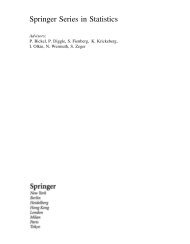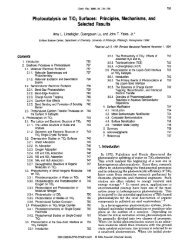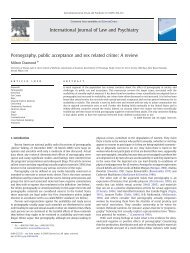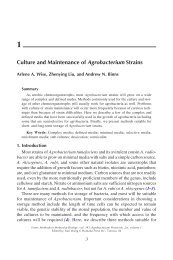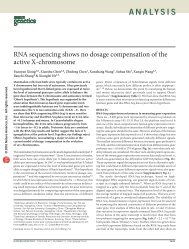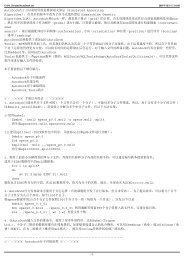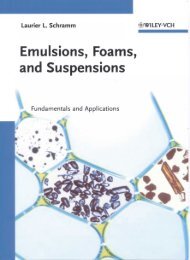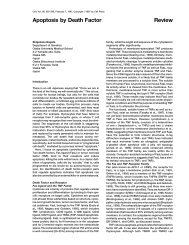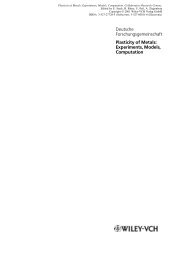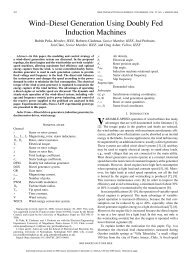SUBCOMMISSION ON GEOCHRONOLOGY: CONVENTION ON ...
SUBCOMMISSION ON GEOCHRONOLOGY: CONVENTION ON ...
SUBCOMMISSION ON GEOCHRONOLOGY: CONVENTION ON ...
You also want an ePaper? Increase the reach of your titles
YUMPU automatically turns print PDFs into web optimized ePapers that Google loves.
Earth and Planetary Sctence Letters, 36 (1977) 359-362 359<br />
© Elsevier Scientific Pubhshmg Company, Amsterdam - Printed m The Netherlands<br />
<strong>SUBCOMMISSI<strong>ON</strong></strong> <strong>ON</strong> GEOCHR<strong>ON</strong>OLOGY: C<strong>ON</strong>VENTI<strong>ON</strong> <strong>ON</strong> THE USE OF DECAY<br />
C<strong>ON</strong>STANTS IN GEO- AND COSMOCHR<strong>ON</strong>OLOGY<br />
compded by<br />
R.H. STEIGER AND E. JAGER<br />
Revised version recelved June 29, 1977<br />
On August 24, 1976 the lUGS Subcommlsslon on Geochronology met in Sydney, Australia, during the 25th<br />
International Geological Congress. It was unantmously agreed to recommend the adoption of a standard set of<br />
decay constants and isotopic abundances in isotope geology. The values have been selected, based on current<br />
information and usage, to provide for uniform international use in published communications. The Subcommls-<br />
slon urges that all isotopic data be reported using the recommended values which are hsted below:<br />
Uramum<br />
X(238U) = 1.55125 X 10-1°/yr [1]<br />
X(23SU) = 9.8485 X 10-1°/yr [11<br />
Thorium<br />
h(232Th) = 4 9475 X 10-11/yr [3]<br />
atomic ratio 238U/235U = 137 88 [21<br />
Rubidium<br />
x(aTRb) = 1.42 X 10 -1 l/yr [4-7] atomic ratio 8SRb/87Rb = 2.59265 [8]<br />
Strontmm<br />
atomic rataos 86Sr/SaSr= 0.1194 [9]<br />
84sr/a6sr= 0.056584 [10]<br />
Potassium<br />
?,(40K3-) = 4.962 X 10-10/yr [11,12]<br />
X(40Ke) + A'(40K e) = 0.581 × 10-10/yr [11,12]<br />
Argon<br />
atomic ratio 40Ar/36Ar atmospheric = 295.5<br />
[131<br />
isotopic abundances 39K = 93 2581 atom% [12]<br />
4°K = 0 01167 atom% [12]<br />
41K = 6 7302 atom% [12]<br />
The recommendation represents a convention for the sole purpose of achieving intedaboratory standardization.<br />
The Subcommlsslon does not intend to endorse specific methods of investigation or to specifically select the works<br />
of individual authors, institutions, or publications. All selected values are open to and should be the subjects of<br />
continuing critical scrutinizing and laboratory mvestlgat~on. The recommendations will be rewewed by the Sub-<br />
commission from time to time so as to bring the adopted conventional values m line w~th slgmficant new research<br />
data.
360<br />
Comment<br />
At the 1972 Internatmnal Geologtcal Congress m<br />
Montreal, Canada, the Subcommissmn on Geo-<br />
chronology decided to work towards the acceptance<br />
of standard decay constants. To achieve this a~m the<br />
Subcommisslon orgamzed the following actwltles.<br />
(A) The Paris 1974 symposmm on the status of<br />
the decay constants and a concomitant inquiry. The<br />
mimeographed report on this meeting [14] was sent<br />
to all laboratories together with the 1975 question-<br />
naire.<br />
(B) The 1975 inquiry by questmnnalre addressed<br />
to all known geochronology laboratories. The results<br />
were presented at the 1976 International Geological<br />
Congress and summarized as follows:<br />
(1) The 1975 survey reflects the opinion of a large<br />
majority of the active geo- and cosmochronologlsts.<br />
(2) The Subcornmisslon on Geochronology has<br />
been entrusted to deal w~th the decay constants prob-<br />
lem.<br />
(3) The Subcommlssion IS urged to adopt and<br />
recommend a standard set of decay constants before<br />
the close of 1976.<br />
(4) Condltmns to assure a wide acceptance of such<br />
a recommendation<br />
(a) The U decay constants by Jaffey et al. [1]<br />
must be the basis for any standard set of<br />
decay constants.<br />
(b) The new value for the 87Rb decay constant<br />
should lie within 1.41 and 1.43 × 10-11/yr,<br />
but there is some reluctance to change to such<br />
a new value before critical experiments now<br />
under way are completed.<br />
(c) The decay constants for 4°K should be dis-<br />
cussed and the values by Beckmsale and Gale<br />
[11 ] taken into consideration.<br />
(C) A session on "The Physical TLme Scale and<br />
Related Problems" at the Symposium on an Interna-<br />
tional Geochronolog~c Scale, 25th International<br />
Geological Congress. In the course of this session all<br />
scientists mterested were invited by the Subcommis-<br />
sion to attend a working session devoted entirely to<br />
the discussion and evaluation of the decay constants.<br />
This meetmg was held on August 20, 1976, with 23<br />
geochronologlsts participating [17].<br />
The large majority of the attending scientists sup-<br />
ported the idea of proposing a standard set of decay<br />
constants It was suggested that such a standard set<br />
were to be issued in the form of recommendation and<br />
that the numbers should be presented as given m the<br />
original pubhcatlon, not rounded off.<br />
Based on the results of the Inquiry it was moved<br />
that the U decay constants by Jaffey et al. [1] be the<br />
mainstay for a standard set This was accepted<br />
together with the 238U/235U ratio of 137.88 [2] used<br />
by the majority of workers. Later it was suggested<br />
that the Th decay constant be Included in a recom-<br />
mendation The value by Le Roux and Glendenm<br />
[3], now adopted by most laboratories, was approved<br />
without further discussion.<br />
The inquiry had revealed that a two-third majority<br />
of the laboratories were using the 1.39 × 10 -1 l/yr<br />
87Rb decay constant [16], which is founded on the<br />
U decay constants by Fleming et al. [15] While most<br />
participants of the working session agreed that a<br />
change in the 87Rb decay constant was mandatory<br />
because of the new U values, there was disagreement<br />
as to how far the adjustment should go. Mere adap-<br />
tlon to the new U constants requiring a change to<br />
about 1.41 × 10-11/yr was supported by some.<br />
Others argued that a value obtained by independent<br />
physical measurement such as the counting experi-<br />
ment by Neumann and Huster [4] and the new value<br />
by the University of Alberta group, Edmonton [6],<br />
should be preferred The Edmonton result of 1.417<br />
-+ 0 011 (95% C L.) X 10-11/yr obtained by measure-<br />
ment of 87Sr accumulated in Sr-free Rubidium salt<br />
had been timely announced at the symposium, just<br />
two days earher. Further arguments for a STRb decay<br />
constant of 1.42 × 10 -I l/yr Included the results of<br />
mtercompanson of coexisting minerals m terrestrial<br />
rocks (Afanass'yev et al [5]), and the comparison of<br />
Rb-Sr and U-Pb ages m meteorites (Wetherlll [18]).<br />
An interesting new comparison of K-At and Rb-Sr<br />
ages m rapidly cooled igneous rocks was presented at<br />
the meeting by Tetley et al. [7]. Their 87Rb constant<br />
estimated on the basis of the Beckmsale and Gale [11]<br />
decay constants for 4°K gave 1 42 +- 0.01 X lO-ll/yr.<br />
It was then moved that in view of the uncertainties<br />
still involved a value for the 87Rb decay constant be<br />
accepted by convention and recommended for pro-
vtsional use. Although the need for more good experi-<br />
ments was recognized some participants were con-<br />
cerned as to whether a provisional recommendation<br />
would have much impact. While the partmlpants sub-<br />
sequently acceded to the idea of a convention recom-<br />
mending a value of 1.42 × 10 -I l/yr, it was agreed<br />
that the problem of the 87Rb decay constant was not<br />
definitely solved Further efforts to obtain high-<br />
quahty determinations were generally advocated<br />
A proposal recommending the use of the 87Rb iso-<br />
topic abundance (8SRb/87Rb = 2 59265) [8] and the<br />
Sr tsotoplc abundance (84Sr/86Sr = 0.05655 or an<br />
updated value) [10] as measured at the U S. National<br />
Bureau of Standards was accepted. On the other hand<br />
it was agreed that the 86Sr/88Sr ratio of0.1194 [9],<br />
universally applied for the normalization of Sr iso-<br />
topic data, should be further used by convention,<br />
regardless of a possible minor change suggested by<br />
measurements currently under way at the National<br />
Bureau of Standards.<br />
The paper read by Tetley et al [7] had quite an<br />
Impact on the discussion regarding the 4°K constant<br />
It was argued that the Becklnsale and Gale [11 ]<br />
values for the 4°K decay were based on a number of<br />
newer and independent counting experiments, which<br />
yielded fairly consistent results. The audience was<br />
informed about some crmclsm of the Beckmsale and<br />
Gale [11 ] paper, which had been raised m response<br />
to the questionnaire. The objections were directed at<br />
the methods used to derive the new 4°K decay con-<br />
stants not at the values themselves. A convention<br />
combining the Beckmsale and Gale [11 ] values with<br />
the new K abundances (4°K = 0 01167 atom%) deter-<br />
mined by Garner et al. [12] was proposed and agreed<br />
on.<br />
The Subcommlsslon on Geochronology is a body<br />
of the Commission on Stratigraphy of the lnterna-<br />
tmnal Union of Geological Sciences (lUGS). The<br />
officers of the Subcommission for the 1972-1976<br />
term responsible for the convention on the decay<br />
constants are"<br />
Chmr * E. Jager, Switzerland.<br />
Secretary * R.H. Stelger, Switzerland.<br />
Members G.D Afanass'yev */* A I. Tugarmov,<br />
* Officers present at the August 24, 1976 meeting in Sydney,<br />
Australia<br />
U.S.S.R., * U.G. Cordanl, Brazd, * R.E. Fohnsbee,<br />
Canada, J.R. Lancelot, France, * I McDougall, Aus-<br />
traha; L.O. Nlcolaysen, South Africa, * K. Shlbata,<br />
Japan, * L.T. Silver, U.S.A., N.J. Snelhng, U K.<br />
References<br />
361<br />
1 A H Jaffey, K F Flynn, L F Glendenln, W C Bentley<br />
and A M Fsshng, Precision measurements of half-hves<br />
and specific actlvmes of 235U and 238U, Phys Rev. C.<br />
4 (1971) 1889-1906<br />
2 W R Shields, Comparison of Belgian Congo and Syn-<br />
thetic "Normal" Samples Table 6 m Appendix A, Report<br />
No. 8, U S National Bureau of Standards Meeting ot the<br />
Advisory Committee for Standard Materials and Methods<br />
of Measurement, May 17 and 18 (1960) 37 pp (unpub-<br />
hshed)<br />
G A Cowan and it H Adler, The vanabihty of the<br />
natural abundance of 235U, Geochlm. Cosmochlm. Acta<br />
40 (1976) 1487-1490.<br />
3 L J Le Roux and L E Glendenm, Half-hfe of 232Th,<br />
Proc Natl Meet. on Nuclear Lnergy, Pretona, South<br />
Africa, April (1963) 83-94<br />
4 W Neumann and E Huster, The half-hfe ot 87Rb mea-<br />
sured as difference bet~ een the isotopes 87Rb and 85Rb,<br />
Z Physlk 270 (1974) 121-127<br />
W Neumann and E Huster, Discussion of the 87Rb half-<br />
hve determined by absolute counting, Earth Planet ScL<br />
Lett. 33 (1976) 277-288<br />
5 G D Afanass'yev, S I Zykov and I M Gorokhov, Corre-<br />
latlvlty of geochronometric ages yielded by coexisting<br />
(cogenetic) minerals with dlffferent 4OK, 87Rb and some<br />
other radioactive elements decay constants, Manuscript<br />
(1974) 19 pp (unpubhshed)<br />
6 D W Davis, J Gray, G L Cummmg and H Baadsgaard,<br />
Determination of the 87Rb decay constant, Geochlm<br />
Cosmochlm Acta (m press).<br />
7 N W Tetley, I S Wdhams, I McDougall and W Comp-<br />
ston, A comparison of K-Ar and Rb-Sr Ages in rapidly<br />
cooled igneous rocks, Preprmt (1976) 3 pp<br />
8 E J Catanzaro, T J Murphy, E L Garner and W R<br />
Shields, Absolute isotopic abundance ratio and atomic<br />
weight of terrestrml rubidmm, J Res U S Natl Bur.<br />
Stand, Sect. A, 73A (1969) 511-516.<br />
9 A O. Nler, Isotopic constitution of Sr, Ba, Bl, T1, and Hg,<br />
Phys Rev 54 (1938) 275-278<br />
10 L J Moore, I L Barnes and T J Murphy, The absolute<br />
abundance ratios and the atomic weight of a reference<br />
sample of strontmm J. Res U.S Natl. Bur Stand, Sect<br />
A (1977) m press.<br />
Note<br />
The new values measured at the U S. National Bureau of<br />
Standards are 0.119353 -+ 3 for 86Sr/88Sr and 0 056562<br />
for 84Sr/86Sr (personal communication by I L Barnes,
362<br />
1977) To obtam a 84Sr/86Sr ratto compatible with the<br />
conventionally used 86Sr/88Sr ratio of 0.1194, the abso-<br />
lute 84Sr/86Sr ratio of 0 056562 was normahzed to a<br />
value of 0 056584 using a factor of 0 1194/0 119353<br />
11 R D Beckmsale and N H Gale, A reappraisal of the decay<br />
constants and branching ratio of 4°K, Earth Planet Sct<br />
Lett 6 (1969) 289-294.<br />
12 E L Garner, T J Murphy, J W Gramhch, P J Paulsen<br />
and I L Barnes, Absolute Isotopic abundance ratios and<br />
the atomic weight of a reference sample of potassium. J<br />
Res. U.S Natl. Bur. Stand., Sect. A, 79A (1976)<br />
713-725.<br />
13 A O. Nler, A redetermmatlon of the relative abundances<br />
of carbon, mtrogen, oxygen, argon, and potassium, Phys.<br />
Rev 77 (1950) 789-793.<br />
14 I McDougall, R H Stelger, and E. Jager, Report on the<br />
Activities of the lUGS Subcommlsslon on Geochronol-<br />
ogy at the "International Meeting for Geochronology,<br />
Cosmochronology and Isotope Geology", organized by<br />
Note added in proof<br />
Prof C J All6gre, Paris, August 26-31 (1974) 5 pp<br />
(unpublished)<br />
15 E H lqemlng, Jr., A Ghtorso and B B Cunnmgham, The<br />
specific alpha-actwltles and half-hves of 234U, 235U, and<br />
238U,Phys Rev 88(1952) 642-652.<br />
16 G W Wetherfll, Radioactive decay constants and energies,<br />
in Handbook of Physical Constants, S Clark, ed, Geol<br />
Soc. Am. Mem. 97 (1966) 513-519.<br />
17 ParUclpants at working session of August 20, 1976, 25th<br />
International Geological Congress, Sydney, Austraha<br />
Australta W. Compston, J A Cooper, C.M Gray, 1<br />
McDougall, D A Nleuwland, R Pldgeon, J. Rlchards, G<br />
Riley, N Tetley, J S Wdhams,Brazd U Cordanl,<br />
Canada R L Armstrong, R E. Fohnsbee, France G S.<br />
Odm, M Roques, M Vachette, Japan K Shlbata,Swzt-<br />
zerland E Jager, R.H Stelger, USA P Damon, M Lan-<br />
phere, M Shafiqullah, L.T. Silver.<br />
18 G W Wethenll, Radlometnc chronology of the early solar<br />
system, Annu Rev Nucl Scl 25 (1975) 283-328<br />
The value of 295 5 for atmospheric 40Ar/36Ar adopted m this convention is derwed from Nler's widely used but rounded percentage<br />
abundances gwen on p. 792 [13] 4OAr = 99 600, 38Ar = 0 063, 36Ar = 0.337 atom% However, m Table III of the same<br />
paper a measured value of 0.003378 -+ 0.000006 is hsted for the 36Ar/4°Ar raho of atmospheric argon which actually corresponds<br />
to a value of 296 0+_ °6 for the 40Ar/36Ar raUo




